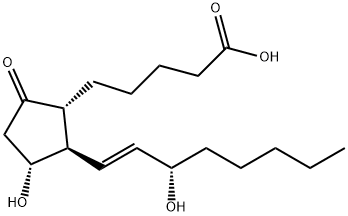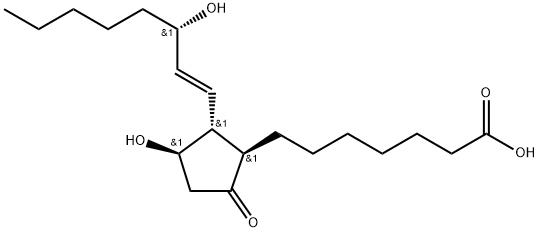2,3-DINOR PROSTAGLANDIN E1
- CAS NO.:7046-40-4
- Empirical Formula: C18H30O5
- Molecular Weight: 326.43
- MDL number: MFCD03411990
- SAFETY DATA SHEET (SDS)
- Update Date: 2023-06-08 09:03:09

What is 2,3-DINOR PROSTAGLANDIN E1?
Description
Prostaglandin E1 (PGE1) is not a major naturally occurring prostaglandin, but it is widely administered clinically for several indications including peripheral occlusive vascular disease, erectile dysfunction and in neonatal cardiology.1,2 The metabolism of PGE1 is normally initiated by oxidation at C-
What are the applications of Application
2,3-dinor Prostaglandin E1 is a metabolite of PGE1
Definition
ChEBI: 2,3-Dinor-PGE1 is a prostanoid.
References
1. Virag, R., Shoukry, K., Floresco, J., et al. Intracavernous self-
2. Hoshi, K. Approved indications of lipo-
Properties of 2,3-DINOR PROSTAGLANDIN E1
| Boiling point: | 508.6±50.0 °C(Predicted) |
| Density | 1.164±0.06 g/cm3(Predicted) |
| solubility | DMF: >100 mg/ml; DMSO: >50 mg/ml; Ethanol: >50 mg/ml; PBS (pH 7.2): 1.67 mg/ml |
| pka | 4.75±0.10(Predicted) |
Safety information for 2,3-DINOR PROSTAGLANDIN E1
Computed Descriptors for 2,3-DINOR PROSTAGLANDIN E1
New Products
(S)-3-Aminobutanenitrile hydrochloride 4-Methylphenylacetic acid N-Boc-D-alaninol N-BOC-D/L-ALANINOL Tert-butyl bis(2-chloroethyl)carbamate 3-Morpholino-1-(4-nitrophenyl)-5,6-dihydropyridin- 2(1H)-one Furan-2,5-Dicarboxylic Acid Tropic acid S-2-CHLORO PROPIONIC ACID ETHYL ISOCYANOACETATE 2-Bromo-1,3-Bis(Dimethylamino)Trimethinium Hexafluorophosphate 4-IODO BENZOIC ACID 3-NITRO-2-METHYL ANILINE 1-(2,4-DICHLOROPHENYL) ETHANAMINE (2-Hydroxyphenyl)acetonitrile 4-Bromopyrazole 5,6-Dimethoxyindanone 2-(Cyanocyclohexyl)acetic acid 4-methoxy-3,5-dinitropyridine 1-(4-(aminomethyl)benzyl)urea hydrochloride 2-aminopropyl benzoate hydrochloride diethyl 2-(2-((tertbutoxycarbonyl)amino) ethyl)malonate tert-butyl 4- (ureidomethyl)benzylcarbamate Ethyl-2-chloro((4-methoxyphenyl)hydrazono)acetateRelated products of tetrahydrofuran
You may like
-
 2033-24-1 98%View Details
2033-24-1 98%View Details
2033-24-1 -
 42831-50-5 5-METHYLISOXAZOLE-4-CARBOXYLIC ACID 98%View Details
42831-50-5 5-METHYLISOXAZOLE-4-CARBOXYLIC ACID 98%View Details
42831-50-5 -
 1975-50-4 98%View Details
1975-50-4 98%View Details
1975-50-4 -
 2-HYDROXY BENZYL ALCOHOL 98%View Details
2-HYDROXY BENZYL ALCOHOL 98%View Details
90-01-7 -
 2-Chloro-1,3-Bis(Dimethylamino)Trimethinium Hexafluorophosphate 221615-75-4 98%View Details
2-Chloro-1,3-Bis(Dimethylamino)Trimethinium Hexafluorophosphate 221615-75-4 98%View Details
221615-75-4 -
 61397-56-6 CIS BROMO BENZOATE 98%View Details
61397-56-6 CIS BROMO BENZOATE 98%View Details
61397-56-6 -
 14714-50-2 (2-Hydroxyphenyl)acetonitrile 98+View Details
14714-50-2 (2-Hydroxyphenyl)acetonitrile 98+View Details
14714-50-2 -
 118753-70-1 98+View Details
118753-70-1 98+View Details
118753-70-1
